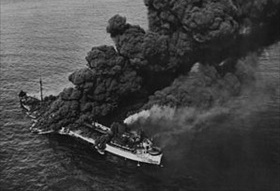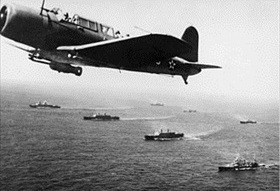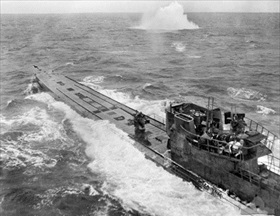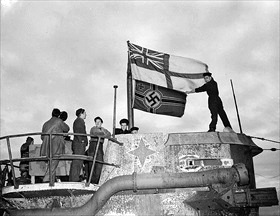CHURCHILL PROCLAIMS BATTLE OF ATLANTIC
London, England • March 6, 1941
By January 1941 the Allies had lost 1,300 merchant vessels, almost half of them to German U‑boats. Following the enslavement of 120 million people in 7 Western and Eastern European countries by Nazi Germany in 1940, the British were reduced to fighting Adolf Hitler’s military juggernaut alone. In alarm they watched the sharp reduction of their food supplies and war material from the U.S. and Canada as the German Kriegsmarine and, to a smaller extent, the Luftwaffe sent merchantman after merchantman to the bottom of the ocean. In 4 months in 1940, from June to September, U‑boats sank 274 ships for a loss of only 2 German submarines. The monthly average of Allied merchant ships sunk jumped from the pre-June 1940 count of 60 per month to 98 per month. As an island nation, the British were highly dependent on imported goods, requiring more than a million tons of imported material per week just to survive and fight. In February 1941 alone U‑boats, aircraft, and mines had destroyed 400,000 tons of shipping, and the rate had been increasing from one month to the next. Losses per transatlantic convoy—escorted by Anglo-Canadian warships—were running at roughly 10 percent. Ship losses were 2 to 3 times larger than the rate at which Britain could build replacements. It was a bleak portrait indeed.
Using the example of the 1940 Battle of Britain, in which the Royal Air Force held Hermann Goering’s Luftwaffe at bay from July to October 1940, British Prime Minister Winston Churchill officially proclaimed the Battle of the Atlantic on this date, March 6, 1941. (The battle, waged across a great expanse of unforgiving ocean and touching three continents, would turn out to be arguably the most arduous and the longest continuous military campaign of the European war.) The next four months, Churchill predicted, would be used to defeat the Kriegsmarine’s attempt to sever the sea-lanes between North America and Britain. Four days later, President Franklin D. Roosevelt threw Britain a lifeline in the form of the Lend-Lease Act. Though the U.S. would not be pulled into war for 9 more months, the hallmark legislation, after vociferous debate in Congress, overturned 3 successive Neutrality Acts from the 1930s aimed at keeping the U.S. out of the European conflict. Lend-Lease gave the cautious Roosevelt administration legal authority to send much-needed military and economic aid to countries whose defense was deemed vital to the U.S. (The president used the months following the Act’s passage to authorize clandestine meetings between U.S. and British military staffers.) The initial authorization of aid totaled $7 billion. By the end of the war U.S. expenditures would top $50 billion (equivalent to $876,680,555 in 2025 dollars adjusted for inflation).
The first Lend-Lease food shipments left the U.S. on April 16, 1941, and helped avert an acute food shortage in Britain. Between April and December 1941, the U.S. delivered 1 million tons of food to Britain. The assistance the U.S. gave its Allies in the early part of the war greatly helped revive the U.S. economy from the effects of the Great Depression and placed it on a firm footing to enable it to join the fight against the Axis powers. When unleashed, the almost limitless power of the U.S. agricultural and industrial economy provided one of the principal weapons in the Allied victory.
Battle of the Atlantic: The Nazi Effort to Starve Britain into Surrender and the Allies’ Response
 |  |
Left: U-boats prowled the U.S. coast early in the war, and on July 15, 1942, the SS Pennsylvania Sun carrying 107,500 barrels of precious Navy fuel oil fell victim to U‑571 125 miles/201 km) west of Key West, Florida, en route from to Port Arthur, Texas, to Belfast, Ireland. The Battle of the Atlantic was chiefly a tonnage war—the Allies eventually winning the struggle to supply Great Britain with food and other agricultural products, steel, oil, armaments, and other key necessities, while the Axis attempted to interdict merchant shipping that enabled the island nation to keep fighting instead of suing for peace. Lasting from 1939 to Germany’s capitulation in May 1945, the battle involved thousands of ships in more than 100 convoy battles and upwards of 1,000 single-ship encounters, all taking place in a watery theater covering over 41 million square miles/106,189,512 square kilometers.
![]()
Right: A Vought SB2U Vindicator scout bomber from the USS Ranger, America’s first purpose-build aircraft carrier launched in 1933, flies antisubmarine patrol over a convoy of merchantmen en route to Cape Town, South Africa, November 27, 1941. The convoy was one of many escorted by the U.S. Navy on “Neutrality Patrol” before the country officially entered the war against the Axis on December 8 (Japan) and 11 (Germany and Italy), 1941. Over time aircraft were the war-winning weapon in the Battle of the Atlantic. Long-range patrol planes and escort carrier aircraft eventually closed the mid-Atlantic gap and made successful U‑boat patrols an increasing rarity from mid-1943 on.
 |  |
Left: German submarine U-848 under attack in the South Atlantic, November 5, 1943. Churchill wrote in his memoirs, “The only thing that ever really frightened me during the war was the U‑boat peril.” “The Battle of the Atlantic was the denominating factor all through the war. . . [E]verything happening elsewhere, on land, at sea or in the air, depended ultimately on its outcome.” There was a period during the winter of 1942–1943 when the U‑boat branch of the Kriegsmarine came close to cutting the North Atlantic lifeline. (The German surface fleet was never a serious factor in the Battle of the Atlantic.) In the first 20 days of March 1943, the Germans sank 97 Allied merchant ships—twice the rate of replacement. However, in that same month the Allies destroyed 43 U‑boats, or 25 percent of the Kriegsmarine’s entire operational submarine strength. Grand Adm. Karl Doenitz briefly withdrew his U‑boats from the main convoy routes and abruptly ended what U‑boat crews had referred to as the “Happy Times” (die glueckliche Zeit). By the end of 1943, after another 39 U‑boats had been dispatched to the bottom of the ocean and a further 54 lost in the first 3 months of 1944, the collective effects of the countermeasures the Allies were employing (e.g., acoustic underwater detection systems, air-to-surface radar in combination with powerful aircraft-mounted searchlights and antisubmarine bombs, Hedgehog and Squid depth charges, increased air patrols over the full length of the convoy routes, and rerouting convoys away from areas where U‑boats were operating) had largely overcome the threat to their merchantmen crossing the Atlantic.
![]()
Right: Canadian seamen raise St. George’s Ensign above a German submarine in St. John’s harbor, Newfoundland, in June 1945. Both the Allies and the Germans paid dearly in battling for control of the Atlantic sea lanes. Between 1939 and 1945, 3,500 Allied merchant ships (totaling 14.5 million gross tons) and 175 Allied warships were sunk and some 72,200 Allied sailors, naval gunners, and merchant seamen lost their lives. The Germans lost 783 U‑boats and roughly three-quarters of their 40,000‑man U‑boat fleet.
Nazi U-Boats Go After Transatlantic Shipping While Allies Search for Countermeasures in the Battle for the Atlantic
![]()

 History buffs, there is good news! The Daily Chronicles of World War II is now available as an ebook for $4.99 on Amazon.com. Containing a year’s worth of dated entries from this website, the ebook brings the story of this tumultuous era to life in a compelling, authoritative, and succinct manner. Featuring inventive navigation aids, the ebook enables readers to instantly move forward or backward by month and date to different dated entries. Simple and elegant! Click
History buffs, there is good news! The Daily Chronicles of World War II is now available as an ebook for $4.99 on Amazon.com. Containing a year’s worth of dated entries from this website, the ebook brings the story of this tumultuous era to life in a compelling, authoritative, and succinct manner. Featuring inventive navigation aids, the ebook enables readers to instantly move forward or backward by month and date to different dated entries. Simple and elegant! Click 











